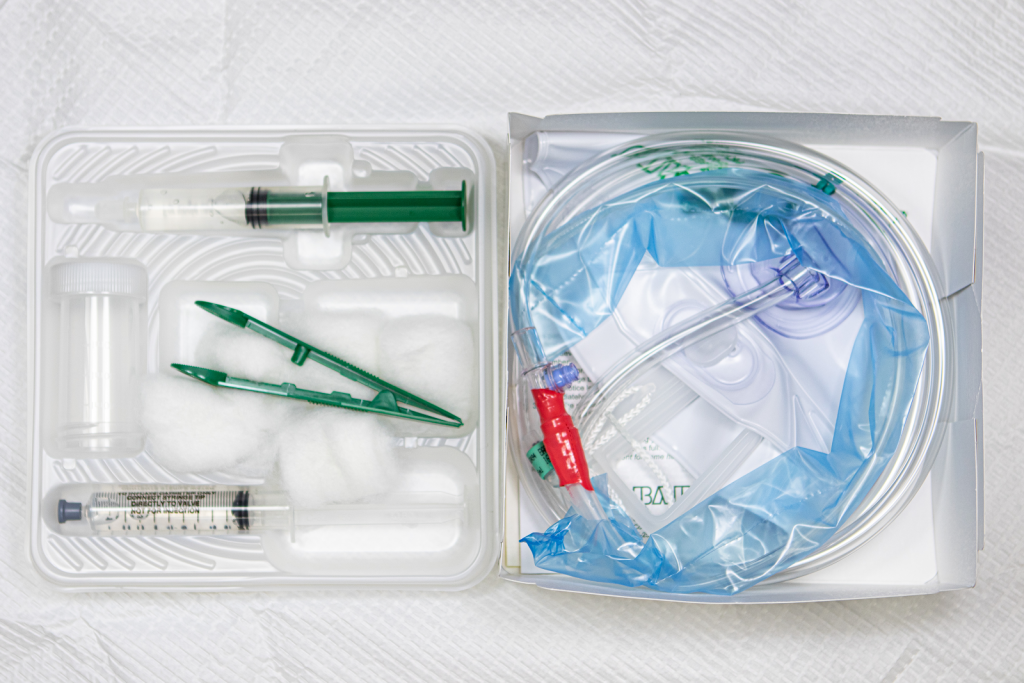21.10 Checklist for Foley Catheter Insertion (Male)
Use the checklist below to review the steps for completion of “Foley Catheter Insertion (Male).”
See Figure 21.20[1] for an image of a Foley catheter kit.

View an instructor demonstration of Male Foley Catheter Insertion[2]:
Steps
Disclaimer: Always review and follow agency policy regarding this specific skill.
- Gather supplies: peri-care supplies, clean nonsterile gloves, Foley catheter kit, extra pair of sterile gloves, VelcroTM catheter securement device to secure Foley catheter to leg, wastebasket, and light source (i.e., goose neck lamp or flashlight).
- Perform safety steps:
- Perform hand hygiene.
- Check the room for transmission-based precautions.
- Introduce yourself, your role, the purpose of your visit, and an estimate of the time it will take.
- Confirm patient ID using two patient identifiers (e.g., name and date of birth).
- Explain the process to the patient.
- Be organized and systematic.
- Use appropriate listening and questioning skills.
- Listen and attend to patient cues.
- Ensure the patient’s privacy and dignity.
- Assess ABCs.
- Assess for latex/iodine allergies, enlarged prostate, joint limitations for positioning, and any history of previous issues with catheterization.
- Prepare the area for the procedure:
- Place hand sanitizer for use during/after procedure on the table near the bed.
- Place the catheter kit and peri-care supplies on the over-the-bed table.
- Secure the wastebasket near the bed for disposal.
- Ensure adequate lighting. Enlist assistance for positioning if needed.
- Raise the opposite side rail. Set the bed to a comfortable height.
- Position the male patient supine with legs extended. Uncover the patient, exposing the patient’s groin, legs, and feet for positioning and sterile field.
- Apply clean nonsterile gloves and perform peri-care.
- Remove gloves and perform hand hygiene.
- Open the outer package wrapping. Remove the sterile wrapped box with the paper label facing upward to avoid spilling contents and place it on the bedside table or, if possible, between the patient’s legs. Place the plastic package wrapping at the end of the bed or on the side of the bed near you, with the opening facing you or facing upwards for waste.
- Open the kit to create and position a sterile field (if on bedside table):
- Open first flap away from you.
- Open second flap toward you.
- Open side flaps.
- Only touch the outer 1” edge of the field to position the sterile field on the table.
- Carefully remove the sterile drape from the kit. Touching only the outermost edges of the drape, unfold and place the touched side of the drape closest to linen, under the patient. Vertically position the drape between the patient’s legs to allow space for the sterile box and sterile tray. Do not reach over the drape as it is placed.
- Wash your hands and apply sterile gloves.
- OPTIONAL: Place the fenestrated drape over the patient’s perineal area with gloves on inside of the drape, away from the patient’s gown, with peri-area visible through the opening. Maintain sterility.
- Empty the syringe or package of lubricant into the plastic tray. Place the empty syringe/package on the sterile outer package.
- Simulate application (do not open) of the iodine cleanser to the cotton. Place package on sterile outer package.
- Remove the sterile urine specimen container and cap and set them aside.
- Remove the tray from the top of the box and place on sterile drape.
- Carefully remove the plastic catheter covering, while keeping the catheter in the container. Attach the syringe filled with sterile water to the balloon port of the catheter; keep the catheter sterile.
- Lubricate the tip of the catheter by dipping it in lubricant and replace it in the box. Maintain sterility.
- If preparing the kit on a bedside table, place the plastic tray on top of the sterile box and carry it as one unit to the sterile drape between the patient’s legs, taking care not to touch your gloves on the patient’s legs or bed linens.
- Place the top plastic tray on the sterile drape nearest to the patient.
- Tell the patient that you are going to clean the catheterization area and they will feel a cold sensation.
- With your nondominant hand, grasp the penis and retract the foreskin if present; position at a 90-degree angle. Your nondominant hand will now be nonsterile. This hand must remain in place throughout the procedure.
- With your sterile dominant hand, use the forceps to pick up a cotton ball. Cleanse the glans penis with a saturated cotton ball in a circular motion from the center of the meatus outward. Discard the cotton ball after use into the plastic outer wrap, not crossing the sterile field. Repeat for a total of three times using a new cotton ball each time. Discard the forceps in the plastic bag without touching your sterile gloved hand to the bag.
- Pick up the catheter with your sterile dominant hand. Instruct the patient to take a deep breath and exhale or “bear down” as if to void, as you steadily insert the catheter, maintaining sterility of the catheter, until urine is noted in the tube.
- Once urine is noted, continue inserting to the catheter bifurcation.
- With your nondominant/nonsterile hand, continue to hold the penis, and use your thumb and index finger to stabilize the catheter. With the dominant hand, inflate the retention balloon with the water-filled syringe to the level indicated on the balloon port of the catheter. With the plunger still pressed, remove the syringe and set it aside. Pull back on the catheter slightly until resistance is met, confirming the balloon is in place. Replace the foreskin, if retracted, for the procedure.
 If the patient experiences pain during balloon inflation, deflate the balloon and insert the catheter farther into the bladder. If pain continues with the balloon inflation, remove the catheter and notify the patient’s provider.
If the patient experiences pain during balloon inflation, deflate the balloon and insert the catheter farther into the bladder. If pain continues with the balloon inflation, remove the catheter and notify the patient’s provider. - Remove the sterile draping and supplies from the bed area and place them on the bedside table. Remove the bath blanket and reposition the patient.
- Remove your gloves and perform hand hygiene.
- Apply new gloves. Secure the catheter with the securement device, allowing room to not pull on the catheter.
- Place the drainage bag below the level of the bladder and attach the bag to the bed frame.
- Perform peri-care as needed.
- Dispose of waste and used supplies.
- Remove your gloves and perform hand hygiene.
- Assist the patient to a comfortable position, ask if they have any questions, and thank them for their time.
- Ensure safety measures when leaving the room:
- CALL LIGHT: Within reach
- BED: Low and locked (in lowest position and brakes on)
- SIDE RAILS: Secured
- TABLE: Within reach
- ROOM: Risk-free for falls (scan room and clear any obstacles)
- Perform hand hygiene.
- Document the procedure and related assessment findings. Report any concerns according to agency policy.
- “Open Foley Kit 3I3A0654.jpg” by Deanna Hoyord, Chippewa Valley Technical College is licensed under CC BY 4.0 ↵
- Open RN Project. (2021, November 11). Male Foley catheter insertion [Video]. YouTube. Video licensed under CC-BY-4.0. https://youtu.be/H6C9FEayN8o ↵

